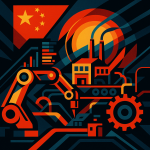Key Points
- The “AI+ Action Plan” is China’s central policy to drive AI application and industrial strategy, moving AI from experimental exploration to value creation.
- The plan addresses issues like supply-demand mismatch and “last-mile” obstacles, aiming to strengthen strategic guidance and promote AI’s revolutionary impact on productivity.
- Key elements include six major “AI+” actions covering science, industry, consumption, public well-being, governance, and global cooperation.
- It also provides eight major supports across models, data, computing power, applications, open source, talent, policies/regulations, and security.
- The establishment of national AI application pilot bases will accelerate large-scale, standardized AI development by solving common industry problems, fostering collaboration, and building shared capabilities.

AI+ Action Plan is the central policy drive shaping China’s next phase of AI application and industrial strategy.

Find Top Talent on China's Leading Networks
- Post Across China's Job Sites from $299 / role
- Qualified Applicant Bundles
- One Central Candidate Hub
Your First Job Post Use Checkout Code 'Fresh20'

NDRC Officials Answer Questions on “Deeply Implementing the ‘AI+’ Action Plan”
Recently, the State Council issued the “Opinions on Deeply Implementing the ‘Artificial Intelligence (AI)+’ Action Plan” (hereinafter referred to as the “Opinions”).
Relevant officials from the National Development and Reform Commission (NDRC) were interviewed to answer questions regarding the “Opinions.”
What is the background for the release of the “Opinions”?
The Central Committee of the Communist Party of China and the State Council attach great importance to the development of artificial intelligence.
In recent years, they have improved top-level design and strengthened work deployment, promoting the overall and systematic leap in China’s comprehensive AI capabilities.
Currently, AI technology is accelerating its iteration and evolution, transitioning from experimental exploration to value creation, bringing profound changes across various economic and social fields and industries.
On one hand, after initial market testing, AI has demonstrated its ability to solve complex problems in real-world scenarios.
Its role in reducing costs, increasing efficiency, and improving total factor productivity in industries is becoming increasingly prominent.
The demand for applications across society is unprecedentedly strong, placing it at a critical window for application implementation.
On the other hand, new intelligent products and scenarios are emerging rapidly.
New generations of smart terminals, such as intelligent connected vehicles, smart wearables, and smart homes, are constantly being innovated.
Intelligent robots are increasingly entering factories and homes, and various intelligent entities are playing important roles in production and daily life.
At the same time, there are still prominent issues such as inconsistent understanding of AI’s role, poor supply-demand matching, and “last-mile” obstacles in application implementation.
There is an urgent need to strengthen strategic guidance and overall coordination to promote a deep understanding of AI’s revolutionary impact on productivity across society.
This will comprehensively advance AI technological innovation, industrial development, and empowerment applications, providing new momentum for accelerating the cultivation of new quality productive forces and promoting high-quality development.
Quick strategic read:
- Why now: AI has moved from lab experiments to practical value creation.
- Where friction exists: mismatched supply-demand, uneven understanding, and last-mile deployment gaps.
- Policy role: top-level coordination to convert AI advances into broad productivity gains.

ExpatInvest China
Grow Your RMB in China:
- Invest Your RMB Locally
- Buy & Sell Online in CN¥
- No Lock-In Periods
- English Service & Data
- Start with Only ¥1,000

What is the significance of implementing the “AI+” Action Plan?
From the perspective of technological development:
It helps to conform to and grasp the evolution of AI technology.
Implementing the “AI+” Action Plan supports scenario-based applications with new scientific research achievements and drives technological innovation breakthroughs with new application demands.
This promotes the dual empowerment of AI technological innovation and application development, helping to address the uncertainty of rapidly changing technology and external environments with the certainty of AI application development, and accelerating the formation of a more vibrant development path with Chinese characteristics.
At the same time, proactively building laws, regulations, policies, and ethical rules adapted to the evolution of AI technology will facilitate the healthy and orderly development of AI in a beneficial, safe, and fair direction.
From the perspective of domestic practice:
It helps promote AI empowerment for high-quality development.
Implementing the “AI+” Action Plan fully leverages China’s abundant data resources, complete industrial system, and broad application scenarios.
It strengthens the widespread and deep integration of AI with various fields, assists in the transformation and upgrading of traditional industries, and opens new tracks for the development of strategic emerging industries and future industries.
This will help stimulate demand growth, accelerate the transformation of growth drivers, and attract global investment in China, thereby contributing to high-quality economic development and ensuring that all people share the dividends of AI development.
From the perspective of the global situation:
It helps build a higher level of international open cooperation.
Implementing the “AI+” Action Plan adheres to AI for good, treating AI as an international public good that benefits humanity.
It extensively promotes international cooperation in AI, advances technological inclusivity and shared outcomes, and co-builds a global AI governance system.
This will further deepen global cooperation, bridge the global intelligent divide, and allow more countries and people to share the development opportunities brought by technological progress.
What investors and founders should note:
- Scenario-first R&D: policy explicitly prioritizes applications that create demonstrable value.
- Regulatory clarity: emphasis on laws and ethics reduces regulatory uncertainty as AI scales.
- Global openness: signals for cross-border cooperation and governance participation.

Resume Captain
Your AI Career Toolkit:
- AI Resume Optimization
- Custom Cover Letters
- LinkedIn Profile Boost
- Interview Question Prep
- Salary Negotiation Agent

What are the main contents of the “Opinions”?
The “Opinions” propose a series of policy measures focusing on synergistic advancement of industry application demands and basic capability supply.
On one hand, driven by industry application demands and coordinating domestic and international efforts, it initiates six major “AI+” actions.
These actions revolve around six key areas: science and technology, industrial development, consumption upgrading, public well-being, governance capacity, and global cooperation.
It deeply analyzes the impact of AI on paradigm shifts across various industries and fields, and prospectively plans the focus points for “AI+” work.
On the other hand, it ensures eight major supports for the “AI+” action, balancing development and security through robust infrastructure and soft construction.
It deeply understands the evolution laws of AI technology and industry, combines internal and external situational changes, and systematically builds an AI basic support system across eight aspects: models, data, computing power, applications, open source, talent, policies and regulations, and security.
Practical implications:
- Six AI+ actions: cover R&D to governance, creating broad investment opportunities across sectors.
- Eight supports: models, data, and computing power are core infrastructural levers highlighted for development.
- Open-source and talent: explicitly part of the support system, signaling ecosystem-level investment potential.

What are the prominent features of the “Opinions”?
The “Opinions” form a series of pragmatic policy measures addressing issues raised by enterprises, emphasizing providing enterprises with direction, confidence, tangible benefits, and accelerated growth.
First, it clarifies policy direction.
It emphasizes application orientation by specifying six major actions in technology, industry, consumption, livelihoods, governance, and global cooperation.
It establishes a dynamic, agile, and multi-collaborative governance system, addressing potential safety risks and employment impacts posed by AI, clarifying development direction and policy expectations.
Second, it strengthens development confidence.
Domestically, it sends positive policy signals, cultivates new models of intelligent development across industrial elements, plans for new intelligent-native business forms, and systematically builds intelligent transformation paths for the three major industries.
Internationally, it upholds inclusiveness and shared benefits, creating an open ecosystem for AI capability building that is equitable, trustworthy, diverse, and win-win, proposing a new model for “AI+” global cooperation.
Third, it highlights tangibility and accessibility.
Adhering to a people-centered development philosophy, it proposes corresponding encouragement directions and support measures for different stakeholders, including scientific researchers, businesses, consumers, the general public, and government departments.
This widely mobilizes the enthusiasm of the entire society to participate in AI development and promotes shared benefits of AI progress for all people.
Fourth, it focuses on practicality and effectiveness.
Adhering to a problem-oriented approach, it proposes a series of targeted measures for issues in AI application implementation, such as emphasizing hardware over software, fragmented applications, and low open-source community activity.
It insists on differentiated policies, proposing integration directions with AI for each field, forming a main line of “AI+” thinking for various industries.
Investor-grade takeaways:
- Enterprise focus: policies designed to reduce friction and create clearer commercialization paths.
- Open ecosystem: active encouragement of open-source and community activity.
- Targeted support: differentiated policy levers mean sector-specific plays will matter.

The “Opinions” propose establishing a batch of national AI application pilot bases. What is the positioning and role of these bases?
Application pilot bases are common capability platforms that accelerate the large-scale, standardized, and systematic development of AI applications.
By establishing application pilot bases in key areas such as manufacturing, healthcare, transportation, finance, and energy resources, in conjunction with the six major “AI+” actions, these bases will gather industry resources and relevant industrial capabilities, cultivate AI professionals, promote application achievements, incubate innovative entities, and build an open ecosystem.
First, focus on common problems and promote industry efficiency improvement.
By integrating high-quality resources, AI will be applied to solve key common problems in industrial development, creating benchmark applications with “high demonstration value and strong driving effect,” thereby promoting overall industry production efficiency improvements.
Second, create a co-creation platform to promote AI industrial development.
It will unblock channels for AI application supply-demand matching, data openness, resource sharing, and technical exchanges, providing an environment for AI application research and development pilot verification.
This will drive technological innovation through application development and incubate and nurture leading AI enterprises and industrial clusters.
Third, solidify common capabilities and significantly reduce the threshold for application innovation.
By implementing “unified technical architecture, unified data standards, and unified standard systems,” it will build common service capabilities for computing power, data, and models, promoting the efficient transformation and popularization of innovative achievements and accelerating large-scale commercial application of AI.
Fourth, cultivate a win-win ecosystem and promote a paradigm shift in industry innovation.
Adhering to open collaboration and mutual benefit, it will accelerate the synergistic development of upstream and downstream industrial chains, building an AI industrial ecosystem with shared resources, complementary capabilities, and positive interaction.
Why pilot bases matter for founders and corporates:
- Lowered entry costs: shared computing and model services reduce duplication and speed time-to-market.
- Market validation: pilot bases create benchmark use-cases that others can emulate.
- Talent pipeline: they act as hubs for training and retaining AI professionals.
- Accelerate large-scale, standardized AI development: Common capability platforms designed for systematic application.
- Focus on common industry problems: Solve key issues with AI, creating benchmark applications for efficiency.
- Create co-creation platforms: Facilitate supply-demand matching, data openness, resource sharing, and technical exchanges.
- Solidify common capabilities: Implement unified technical architectures, data standards, and standard systems.
- Cultivate a win-win ecosystem: Promote synergistic development across industrial chains for shared resources and capabilities.

What are the next steps for implementing the “Opinions”?
First, strengthen overall work coordination.
The National Development and Reform Commission will reinforce its leading role, strengthen overall coordination, and form a joint effort.
It will promote all regions and departments to closely integrate with their realities, formulate tailored implementation measures, ensure thorough implementation, and widely build social consensus, avoiding problems such as rash action, fragmentation, and superficiality.
Second, clarify phased key tasks.
In collaboration with relevant departments, and comprehensively considering the application potential, maturity, and driving effects of various industries, it will further select application scenarios with significant variable value, clarify phased key tasks, and dynamically update them, achieving a combination of long-term and short-term, dynamic and static approaches.
Third, foster a favorable application environment.
It will continue to improve relevant laws, regulations, policies, application standards, and ethical rules, increase financial and fiscal support for AI, refine application trial-and-error tolerance management systems, and encourage key scenarios to be “brave in openness” and “truly open.”
It will promote government departments and state-owned enterprises to strengthen their exemplary leadership role by opening up scenarios to support technology implementation.
Fourth, promote industrial ecosystem development.
It will drive the intelligent development of all industrial elements, cultivate AI application service providers, build an AI application service chain, vigorously develop intelligent-native technologies, products, and service systems, and foster intelligent-native enterprises.
It will strengthen the construction of the open-source ecosystem, support the development of high-quality open-source projects, and enhance international influence.
Fifth, strengthen the prevention of security risks.
It will continue to strengthen the research, evaluation, and response to the impact of AI applications on industrial structure and employment structure, enhance the job creation effect, and mitigate the job displacement effect.
It will establish and improve AI technology monitoring, risk early warning, and emergency response systems to prevent and resolve relevant security risks and challenges brought by AI.
Action checklist for stakeholders:
- Policy teams: align product roadmaps to prioritized scenarios (manufacturing, healthcare, transport, finance, energy).
- Investors: prioritize startups that can plug into unified technical architectures and pilot bases.
- Corporate leaders: open up real-world scenarios and partner with pilot bases to accelerate adoption.
- Open-source contributors: engage with ecosystem projects to increase international influence.

Final perspective and value signals for the market
The “AI+” Action Plan is engineered to convert technological momentum into large-scale economic value through coordination of policy, infrastructure, and practice.
It explicitly targets the classic commercialization bottlenecks: standardized architectures, shared data and computing services, and scenario validation through pilot bases.
For investors and founders, the clearest opportunities lie in companies that deliver common service capabilities (models, computing power, unified data standards) and those that integrate tightly with the proposed pilot bases in core sectors.
For corporates and governments, the plan reduces friction to scale AI implementations by committing to open scenarios, regulatory clarity, and ecosystem support.
For the open-source community, the emphasis on high-quality projects is an invitation to build and lead foundational components that will be reused across industries.
This is a practical, coordinated roadmap meant to move China from isolated AI experiments to large-scale, efficient, and governable AI-powered industries under the AI+ Action Plan.

References
- National Development and Reform Commission: Promoting Intelligent Development Across Industrial Elements, Cultivating AI Application Service Providers, and Building an AI Application Service Chain – National Development and Reform Commission
- China’s computing power platform fully connected, smart computing scale to grow over 40% this year – Eastmoney Finance
AI+ Action Plan is the policy lens investors, founders, and ecosystem builders should watch right now.




